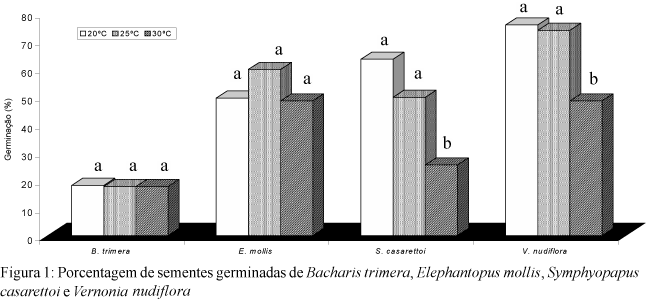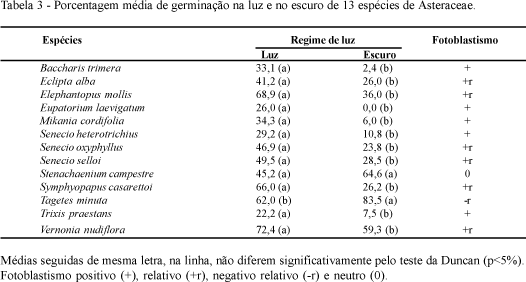Achenes of thirteen native Asteraceae species common to the natural grassland or weeds of the southern region of Brazil were tested for germination over a range of alternating temperatures ( 20/10; 25/15; 30/20 and 35/25°C), and under constant temperatures ( 20; 25 and 30°C) with light or not .Only fresh collected achenes (herein = seeds) were used. The optimum temperature for germination differed among the species, with Elephantopus mobillis; Eupatorium laevigatum; Mikania cordifolia; Senecio oxyphyllus; Trixis praestans germinating the most over all temperatures tested. Eclipta alba seeds germination was promoted at 30°C. Colder treatments promoted germination in Tagetes minuta , and in Senecio heterotrichius; S.selloi; Stenachaenium campestre; Symphyopappus casarettoi and Vernonia nudiflora germination was equivalent at 20 or 25°C. Light promoted germination for all species except in Stenachaenium campestre and Tagetes minuta, the latter being a negative photoblastic species. According to the mean time for germination, the species could be ranked in: fast -less than 5 days- (Baccharis trimera; Eclipta alba; Elephantopus mollis; Stenachaenium campestre and Vernonia nudiflora); intermediate: between 5 and 10 days- (Eupatorium laevigatum; Mikania cordifolia and Tagetes minuta) ; slow: more than 10 days-(Senecio heterotrichius; S.oxyphyllus; S.selloi; Symphyopappus casarettoi; Trixis praestans). The results show that germination of seeds of a range of Asteraceae species varies with temperature and light regime; they provide an initial basis on which to test and interpret the effects of seasonal factors on germination and field establishment. In addition, comments on the agar and sand substrates were made.
Germination; temperature; light; Compositae; Senecio; Baccharis; Eclipta; Elephantopus; Eupatorium; Mikania; Stenachaenium; Symphyopappus; Tagetes; Trixis






